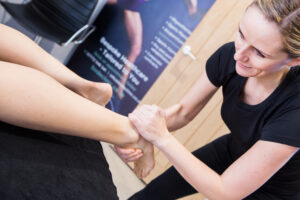Here are some common foot problems experienced by walkers.
With the Peaks on our doorstep, walking and hiking are common pastimes for the people of Greater Manchester. Walking is a massively underrated exercise which has fantastic benefits for both our physical and mental health. However, it is important to keep our feet healthy so we can continue with this great hobby.
- Blisters
Those pesky little (or big) bubbles of fluid we tend to get on our heels, toes, and soles of our feet. We’ve all had one and know how painful they can be. This is actually the body’s way of healing damaged tissue. The blister is a helpful, protective mechanism to keep bacteria away from the damaged tissue. The blister will usually resolve on its own so it is best to let it do its thing. You can try to avoid blisters by wearing comfortable walking shoes or boots that keep your feet dry. Wearing appropriate socks and footwear is very important for your feet!
- Plantar fasciitis
Fascia is a type of connective tissue which can be found in various places around the body. The plantar fascia supports the arch in your foot and helps to absorb some of the shock caused by walking. Plantar fasciitis is the inflammation of the plantar fascia which is found in the underside of your foot. If you experience pain in the sole of your foot around the arch and heel this could indicate plantar fasciitis. Using supportive footwear and possibly insoles to support your arches can help to deter any pain in this area. Your physiotherapist can provide exercises to help ease the symptoms of plantar fasciitis.
- Ankle sprain
Walking on uneven ground can unfortunately lead to injuries sometimes. One of the most common injuries from walking is ankle sprains. Ankle sprains affect the ligaments which are found in the ankle joint and are caused by overstretching the ligament. There are 3 different grades of ankle sprain. Grade 1 is some slight tearing which will cause some pain, tenderness, and stiffness around the ankle, but you should be able to walk on it. Grade 2 is a bit more tearing and will likely be accompanied by pain, swelling, and bruising, and walking on it will be painful. Grade 3 is a complete tear. There will be severe swelling and bruising and the ankle will feel unstable. It is unlikely you will be able to walk on an ankle with a Grade 3 sprain as it will be extremely painful. Ankle sprains can be avoided by wearing appropriate footwear, paying attention to your path, and walking at your own pace. Your physiotherapist can guide you through the healing process and help to strengthen your ankle again.
These are just some common foot problems that we see in those who enjoy walking. Although we need to be careful when enjoying the beautiful nature around this country, it is still a wonderful form of exercise with proven mental health benefits. If you find yourself injured from walking, book in to Bode Clinic and we will be delighted to help you.

You can book online using this link
Happy walking!
– Laura McLean
